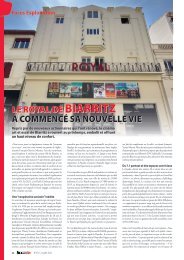You also want an ePaper? Increase the reach of your titles
YUMPU automatically turns print PDFs into web optimized ePapers that Google loves.
Adue/dlUnja<br />
Jill<br />
Sixth Sense in Film Merchandising,<br />
A Psychological Study of Selling<br />
by BEN ADLER<br />
Specialists count these days. As always,<br />
there is room at the top for the best, the<br />
most skillful, the most practical.<br />
The hall of advertising fame includes such<br />
inveterate third dimensional, practical leaders<br />
as Howard Dietz, Mort Blumenstock, Si<br />
Seadler, Charles Schlaifer, Stan Sruford,<br />
Barrett McCormick, Maurice Bergman, Max<br />
Youngstein, Al Zimbalist and Lou Lifton, to<br />
mention just those whose names are most<br />
familiar to exhibitors.<br />
They are the pace-setters. Their efforts,<br />
study, research and actual experience is<br />
poured into all advertising media for motion<br />
pictures that reaches every city, town and<br />
hamlet. It is their responsibility to lay the<br />
initial groundwork for reducing sales resistance<br />
on product which the exhibitor later will<br />
offer to his patrons.<br />
It is almost impossible to recognize the<br />
importance and the magnitude of this responsibility.<br />
Without this preparatory effort,<br />
without this groundwork, without these basic<br />
THE contributor of this article is well known<br />
to readers of BOXOFFICE. Adler is art<br />
director for Warner<br />
Theatres in New Jersey.<br />
He is also established<br />
as art and advertising<br />
consultant<br />
for several major and<br />
independent distributors.<br />
A previous article<br />
by Adler, "Making<br />
Big Ones Into Little<br />
Ones," appeared in the<br />
Showmandiser section<br />
July 26, 1947. In it,<br />
Adler gave many pointers<br />
for theatremen on<br />
Ben Adler<br />
how large mats could be utilized for small<br />
budget ads. His experience and his talent<br />
make him a;n authority on theatre advertising.<br />
The Showmandiser section is happy to<br />
pass his ideas on to the readers.<br />
selling angles, the exhibitor's selling job<br />
would be far more difficult. True, revamping<br />
is a necessary part of the exhibitor's<br />
job, but that is a requisite to meet entertainment<br />
appetites in diverse communities.<br />
Basically, the advertising leaders in our industry<br />
probe every single exploitable angle<br />
and provide for the working man behind the<br />
boxoffice a gold-mine of solid ingredients<br />
culled from talents of production mechanics.<br />
BROAD AID TO EXHIBITOR<br />
These are the pressbook advertisements,<br />
the refined product in actual art and copy<br />
thinking in a variety of sizes and layouts.<br />
It is noteworthy that no other industry makes<br />
available to the retailer such a vast reservoir<br />
of practical salesmanship. It is noteworthy<br />
that no other industry has perfected<br />
the functional use of third dimensional advertising<br />
as well as the Barnum-magicians<br />
associated with motion pictures.<br />
Third dimensional advertising—the process<br />
is eternal. Sales views change with the times.<br />
You must find out what the patrons want,<br />
give them what they want and advertise it<br />
the way they want it. In this technique, a<br />
sixth sense is developed. An instinctive, intuitive<br />
method of reaching the theatre patron<br />
through advertising and ballyhoo. Tlie<br />
finished newspaper advertisement is the result<br />
of such fundamental elements as good<br />
layout, copy, type, art and lettering.<br />
The well-designed advertisement is styled<br />
immediately to direct all attention to itself<br />
and in so doing seems to embrace the feel of<br />
one, two or all of the five senses.<br />
Illustrations which accompany this article<br />
serve to illustrate how the senses are automatically<br />
brought into play as the reader<br />
looks at the advertisement.<br />
Fir^ there is the visual sensitivity (sight)<br />
activated in the ad for "The Search." Vision<br />
being the most complex of all special sensitivities,<br />
most of the readers' effort is directed<br />
towards getting the brain thinking from solely<br />
a visual interpretation of the sales message.<br />
The auditory sensitivity (hearing) is brought<br />
into play through various ingenious devices.<br />
The ad for "Deep Waters," as an example,<br />
calls upon the auditory sensitivity as well as<br />
the eye for interpretation. This is achieved<br />
by the caption, "The Sea Is a Woman-<br />
Beautiful . . . and. Like You .<br />
Here we find a feeling of vibration and<br />
rhythm which the eye will pass on to the<br />
ear. The lower portion of the advertisement<br />
on "The Emperor's Waltz" serves as another,<br />
more elementary illustration. This method<br />
employs the use of musical notes, the openmouthed<br />
expression of the characters, which<br />
the eye will pass on to the ear in a series of<br />
musical tones and sounds.<br />
In the "Key Largo" ad, we see how the<br />
cutaneous sensitivity (touch) is stimulated.<br />
Here the responsive advertising chords are<br />
activated by surface contact. (Bogart's hands<br />
with Bacall's face). Although qualitative differences<br />
exist between various pressures, pain,<br />
cold, warmth, etc., this sense becomes involved<br />
when the ad man succeeds in making<br />
the observer feel that he can reach out and<br />
touch. The prospective buyer should be placed<br />
in the vicarious position of the ad subject<br />
who is experiencing the sensation we are<br />
creating by art or copy. The ticket buyer<br />
finds himself imagining that he is Bogart.<br />
Tire sensation is his. A scene showing two<br />
persons dancing in embrace will automatically<br />
invoke the cutaneous sensitivity.<br />
AROUSING SENSE OF SMELL<br />
Visualize for yourself an incense burner<br />
with a wreath of smoke trailing upward in<br />
the foreground of the advertisement illustrated<br />
for "Atlantis."<br />
Here we would have the necessary<br />
elements to arouse the olfactory sensitivity<br />
(smell). Inmiediately the eye transmits the<br />
picture to the brain, the observer is unconsciously<br />
awai'e of an oriental background.<br />
The olfactory sense comes into play, stirring<br />
memories of scents which he associates with<br />
orientals, the odor of burning incense, perhai>s<br />
a perfume. The olfactory sense is excited<br />
through various other devices, flowers,<br />
particularly those which have a distinctive<br />
scent, culinary dishes, grassland or farm<br />
32 —634— BOXOFFICE Showmandiser : : August 21, 1948 \\

















